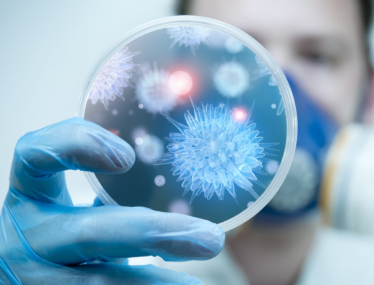Harnessing microbial machinery in the hunt for new antibiotics
By Dr Wayne Bowen

Global antibiotic resistance is a threat to our very existence. We need ingenious ways to discover new bug-defeating drugs, and fast.
Now, new approaches have emerged to explore the depths of microbe biochemistry for previously unexploited compounds.
The availability of potent antibiotics is taken for granted in the modern era. However, every year, the bacterial resistance problem gets a bit worse and currently our best drug discovery efforts are only slowing down the onslaught. Bacteria that resist nearly all antibiotics are continuing to spread worldwide. A 2013 report estimated that over 20,000 Americans die each year as a direct result of untreatable infections. For now, at least 90% of multi-resistant infections in the US can still be killed by at least one antibiotic of last resort, but this shows how perilously close we are to returning to the pre-antibiotic era, a time when bacterial infection was a major cause of mortality and a simple scratch could be fatal.
Fighting bacterial infection is a never-ending war, with the upper hand delicately balanced between microbes and humans. Until the mid-1940s, microbes had almost free reign, until, following the introduction of penicillin, humans gained the advantage. Over the following twenty years, twenty new classes of antibiotics were brought to market. But, over time, microbes developed resistance to each one. From the mid-60’s until today we have generated just three new classes of antibiotics, with microbial resistance for each emerging within a few years of their deployment. Analogs have kept pace (to some extent) with emerging resistance, but this trend cannot continue for much longer. New antibiotic discovery is at an all-time low for many reasons; the “low-hanging fruit” has been harvested, financial returns have decreased, and, possibly, we are simply in denial about the scale of the problem.
Thankfully, all is not lost and there is time to regain the upper hand using new microbial techniques. This post will focus on some of the recent state of the art efforts to generate novel antibiotics from microbes.
Novel microbes – The Great Plate Count Anomaly
The Great Plate Count Anomaly has troubled scientists for many years. This anomaly is the difference between the number of observed microbes in the soil and those that can be cultured in the laboratory. It is estimated that less than 1% of existing bacteria have been cultivated. iChip technology from Northeastern University has demonstrated an ability to domesticate approximately ten times more microbial species from the soil than those that can be obtained using traditional techniques. Teixobactin (NovoBiotic Pharmaceuticals) is one of a new class of antibiotics discovered using iChip technology, made by a newly isolated microbe found in soil from a grassy field in Maine. Further advances in culturing, through an understanding of the exogenous conditions required for bacterial growth, are anticipated to continue increasing the numbers of accessible organisms. These novel species may provide new engines for the discovery of novel classes of antibiotics.
Novel compounds – The Great Antibiotic Count Anomaly
The Great Antibiotic Count Anomaly is the difference between the number of antibiotics that have been generated in culture versus the total potential antibiotics that may be generated from known microbial species. It is estimated that less than 10% of the possible antibiotics generated by actinomycetes, the most productive order of antibiotic producing microbes, have been identified.
It is quite understandable that microbes, like humans, want to keep their offensive weapons under tight control and only produce them at times of imminent danger. Cultivation under normal laboratory conditions is typically not designed to threaten microbes. Stimulation by non-specific chemical or physical stressors has been shown to increase antibiotic production to some extent, as has co-culturing with other microbes. What is needed is an understanding of the keys required to unlock the well-controlled arsenal within each microbe. Prospective Research, Inc. is using small chemical keys designed to specifically activate silent gene clusters and generate novel secondary metabolites. They have demonstrated stimulated production of known antibiotics (increased more than 400x), significantly enhanced bioactivity compared to untreated controls, and significantly increased number of distinct secondary metabolites. Adam Hill, Prospective Research’s CEO commented “As research progresses to identify regulators of these pathways, activating silent gene clusters in native organisms will be a way to rapidly access novel antibiotics. This technology opens the potential to rescreen the millions of microbial isolates in freezers today, as well as newly domesticated species.”
Engineered microbes – the potential of synthetic biology for de novo discovery and SAR
The advent of synthetic biology gives us another opportunity to fight microbial infection. Biosynthetic gene cluster isolation and heterologous host expression provides a promise of unending permutations and combinations of building blocks to form novel antibiotics. WarpDrive Bio, among others, has been working to identify secondary metabolite gene clusters and have been organising the biosynthetic operons into heterologous hosts to specifically express antibiotics. Given the propensity for biosynthetic pathways to be encoded by chromosomally adjacent genes, the stringing together of building blocks in different orders can lead to a vast diversity of structures. Initial work with known antibiotics has highlighted some of the difficulties of this approach and the number of molecules generated in this fashion over the last 10 years has been rather small. As with most new technologies and approaches, however, a period of exploration is required to appreciate its potential and complexity. Thus, time continues to be invested in gaining understanding of the rules governing what is made, as well as what is desirable to make, to support the rapid growth in this field. Knowing what to combine to develop de novo antibiotics or how to combine building blocks to rapidly produce bioactive structural analogs will leverage this technology for rapid development of the next generation of antibiotics.
Summary
In the golden age of antibiotic discovery, the number of microbial isolates required to discover a new class of antibiotics was manageable. It is estimated that actinomycin could be found by screening 10-1000 actinomycetes, chloramphenicol 10,000, less than a million microbes to find vancomycin and erythromycin. The discovery of daptomycin in the mid 1980’s required screening of 10 million strains. In order to be productive, we need to bring these numbers back down below the million strain mark; both the science and the technology is advancing to address this challenge.
We have found mechanisms to counter the Great Plate Count Anomaly (buying us 10x in microbial diversity), the Great Antibiotic Count Anomaly (10x in secondary metabolite diversity), and the difficulties in generating SAR in natural products. Aligning these approaches gives us tools to fight the rise of antibiotic-resistant microbes and regain the upper hand. Establishing the political and financial incentives to apply these mechanisms proactively perhaps should be the subject of another blog.



